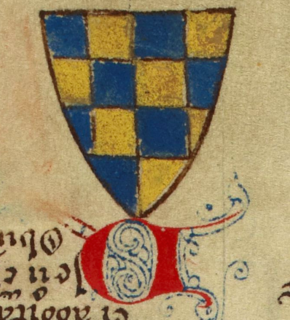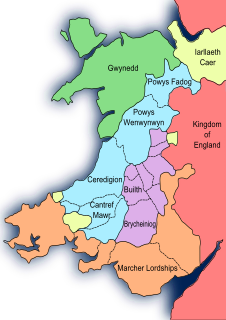
William Marshal, 1st Earl of Pembroke, also called William the Marshal, was an Anglo-Norman soldier and statesman. He served five English kings—Henry II, his sons the "Young King" Henry, Richard I, and John, and finally John's son Henry III.

The Earldom of Pembroke is a title in the Peerage of England that was first created in the 12th century by King Stephen of England. The title, which is associated with Pembroke, Pembrokeshire in West Wales, has been recreated ten times from its original inception. Due to the number of creations of the Earldom, the original seat of Pembroke Castle is no longer attached to the title.

William de Forz, 3rd Earl of Albemarle was an English nobleman. He is described by William Stubbs as "a feudal adventurer of the worst type".
The County of Aumale, later elevated to a duchy, was a medieval fief in Normandy. It was disputed between England and France during parts of the Hundred Years' War.

William de Warenne, 5th Earl of Surrey was the son of Hamelin de Warenne and Isabel, daughter of William de Warenne, 3rd Earl of Surrey. His father Hamelin granted him the manor of Appleby, North Lincolnshire.

William Marshal, 2nd Earl of Pembroke was a medieval English nobleman and was one of Magna Carta sureties. He fought during the First Barons' War and was present at the Battle of Lincoln (1217) alongside his father William Marshal, 1st Earl of Pembroke, who led the English troops in that battle. He commissioned the first biography of a medieval knight to be written, called L'Histoire de Guillaume le Mareschal, in honour of his father.

Richard Marshal, 3rd Earl of Pembroke, was the son of William Marshal, 1st Earl of Pembroke and brother of William Marshal, 2nd Earl of Pembroke, whom he succeeded to the Earldom of Pembroke and Lord Marshal of England upon his brother's death on 6 April 1231.

Gilbert Marshal, 4th Earl of Pembroke was the third son of William Marshal, 1st Earl of Pembroke and Countess Isabel, the daughter of Richard son of Gilbert, earl of Striguil.

The Lordship of Glamorgan was one of the most powerful and wealthy of the Welsh Marcher Lordships. The seat was Cardiff Castle. It was established by the conquest of Glamorgan from its native Welsh ruler, by the Anglo-Norman nobleman Robert FitzHamon, feudal baron of Gloucester, and his legendary followers the Twelve Knights of Glamorgan. The Anglo-Norman Lord of Glamorgan, like all Marcher lords, ruled his lands directly by his own law: thus he could, amongst other things, declare war, raise taxes, establish courts and markets and build castles as he wished, without reference to the Crown. These privileges were only lost under the Laws in Wales Acts 1535–1542. Though possessing many castles, the main seat of the Lordship was Cardiff Castle.

Isabel de Forz was the eldest daughter of Baldwin de Redvers, 6th Earl of Devon (1217–1245). On the death of her brother Baldwin de Redvers, 7th Earl of Devon in 1262, without children, she inherited suo jure the earldom and also the feudal barony of Plympton in Devon, and the Lordship of the Isle of Wight. After the early death of her husband and her brother, before she was thirty years old, she inherited their estates and became one of the richest women in England, living mainly in Carisbrooke Castle on the Isle of Wight, which she held from the king as tenant-in-chief.
Isabel de Clare, suo jure 4th Countess of Pembroke and Striguil, was an Anglo-Irish noblewoman and one of the wealthiest heiresses in Wales and Ireland. She was the wife of William Marshal, 1st Earl of Pembroke, who served three successive kings as Marshal of England. Her marriage had been arranged by King Richard I.
Eva Marshal (1203–1246) was a Cambro-Norman noblewoman and the wife of the powerful Marcher lord William de Braose. She was the daughter of William Marshal, 1st Earl of Pembroke, and the granddaughter of Strongbow and Aoife of Leinster.

Katherine Mortimer, Countess of Warwick was the wife of Thomas de Beauchamp, 11th Earl of Warwick KG, an English peer, and military commander during the Hundred Years War. She was a daughter and co-heiress of Roger Mortimer, 1st Earl of March and Joan de Geneville, Baroness Geneville.

Walter Marshal, 5th Earl of Pembroke was the fourth son of William Marshal, 1st Earl of Pembroke and Countess Isabel, the daughter of Richard son of Gilbert, earl of Striguil.
Aveline de Forz, Countess of Aumale and Lady of Holderness was an English noblewoman. A great heiress, in 1269 she was married to Edmund Crouchback, 1st Earl of Lancaster, the second son of Henry III of England. She died five years later, and the marriage produced no children.
Gilbert Basset was an English baronial leader during the reign of King Henry III.

The feudal barony of Plympton was a large feudal barony in the county of Devon, England, whose caput was Plympton Castle and manor, Plympton. It was one of eight feudal baronies in Devonshire which existed during the medieval era. It included the so-called Honour of Christchurch in Hampshire, which was not however technically a barony. The de Redvers family, first holders of the barony, were also Lords of the Isle of Wight, which lordship was not inherited by the Courtenays, as was the barony of Plympton, as it had been sold to the king by the last in the line Isabel de Redvers, 8th Countess of Devon (1237–1293).

Richard Siward, Lord of Kellie, was a 13th-14th century Scottish noble. He was the son of the English adventurer Richard Siward and his wife, the wealthy heiress and widow Philippa Basset countess of Warwick, who had married in 1230. His parents divorced in 1242 and young Richard remained in the custody of his father by the terms of the settlement. The Siwards moved north to Scotland after this, where King Alexander II offered the elder Richard a place in his household and gifts of land in Fife, including Kellie and lands in Aberdour. On his death in 1248 the young Richard remained in Scotland, presumably as a royal ward. He inherited no share of his mother's lands.

Philippa Basset, Countess of Warwick, was a 13th-century noblewoman and heiress. She was the wife firstly of Henry (II) de Newburgh, earl of Warwick and after his premature death she was married to Richard Siward a soldier and adventurer at the court of King Henry III of England.
Morgan Gam was a Welsh lord of Afan, a small Welsh lordship in Glamorgan.












